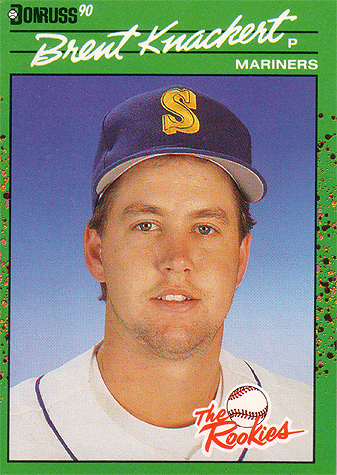
1989 Donruss The Rookies
Now we get into a player that I contemplated collecting back in 1989. Bill Spiers wasn’t exactly a giant hit in our neighborhood, but I liked him, and I thought he had a solid future in the majors. I briefly flirted with the idea of collecting his cards, but decided to pass after all, as I had no real connection the Brewers outside of liking Paul Molitor and Robin Yount.
Bill was the Brewers’ 1987 first-round pick from Clemson University. He had hit 17 home runs as a shortstop there, hitting .325 with a reputation for slick fielding, as well as serving as the team’s punter, averaging 39.2 yards a punt. He was expected to anchor the kicking team for Clemson in 1987, but when he accepted the Brewers’ offer, the football team had to scramble for a solution.
Here’s a shot of Bill from his time with the Clemson team, scoring against Wake Forest:

I also found a picture from his time with the Peninsula Oilers of the Alaskan League:


1989 Fleer Update
Bill started with rookie league Helena in 1987, hitting .409/.480/.455 in 6 games there before getting moved up to A-level Beloit, where he hit .298/.344/.380 in 64 games. It was a damned good start for a shortstop, especially one with a good defensive reputation. He was already getting a bit of a reputation as a fiery player, though.
In 1988, he got some time with the team in Spring Training before being sent down to high-A Stockton, where he hit .269/.353/.377 in 84 games. The Brewers advanced him again, this time to AA El Paso, where he spent the rest of the season hitting .280/.344/.387.

1989 Score Rookie and Traded
Spiers was invited back for Spring Training in 1989 and made the team in a surprising decision, splitting time with Gary Sheffield before Sheffield was moved over to third despite his protests. Spiers’ first game was April 7th, at home against the Tigers, where he had no hits; his first major league hit would have to wait until April 10th, when he started against the Rangers in Arlington. He wouldn’t get a hit again until April 17th. He came into the game hitting .063/.158/.063, but went 2 for 2 that day with his first homer, a grand slam off of Brad Arnsberg to put the game out of reach in the top of the 9th. Unfortunately, he would only get one more hit in April, going .154/.258/.269 for the month.
May would be a little kinder, though. He only played in one game between April 30th and May 6th, getting no hit, but he broke out again on the 6th, going 2-for-3 with a run, bringing his line up to .194/.297/.290. Between then and the end of the month, he would go .288/.373/.346 with 3 doubles and 4 stolen bases.

1989 Topps Traded
June was a disaster, though. He hit just .200/.259/.200 before he was sent down to AAA Denver, where he would hit .362/.423/.574 with 2 homers in 14 games before being called back up. He made his return to the majors as a defensive replacement on July 16th, then a late-inning replacement again on the 17th, getting a hit there and earning a start on July 18th. He went 1-for-4 in that game, and began to steadily hit, his numbers increasing throughout the month. He hit .341/.333/.341 with two homers in July, boosting his numbers to .262/.317/.302. This was about the time I started to notice him, as I recall.
He got steady play throughout August, but failed to match his torrid pace from July, hitting .180/.232/.213, falling to .231/.286/.269.

1989 Upper Deck High Numbers
But the Brewers stuck with him, and he improved his game in September, hitting .308/.327/.477 for the month, ending at .255/.298/.333. Obviously, the OBP was a concern, but overall the Brewers were happy with his glove, especially. At this point I would have declared his career at a crossroads; plenty of players had arrived at this point and never gone anywhere in the past, but he was only 23 and had time to improve. He hit worse in 1990 and returned to AAA again for a bit, then rebounded in 1991, finally showing the offensive promise he had shown in the minors. Then he got injured in 92, missing almost all of the season and moving off of SS permanently, as his range was much reduced. He stuck around in the majors until 2001, though, spending time between AAA and the majors with the Mets and the Astros. His final career line was .271/.341/.370 with 37 home runs and 97 stolen bases. Certainly not what was predicted for him, but I can’t hate on him for a career like that.















































